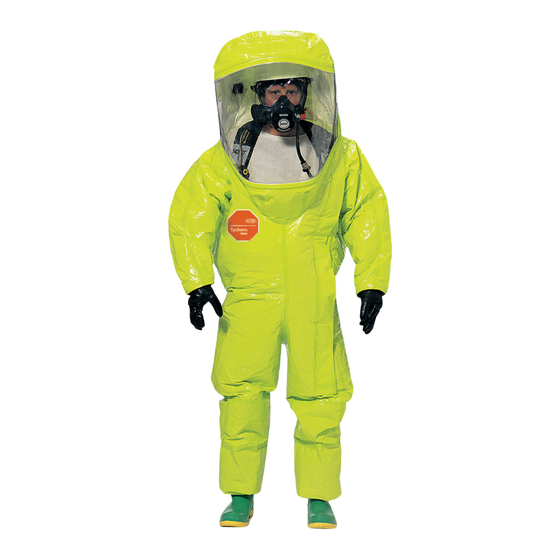- ページ 11
安全装置 Dupont Tychem VaporのPDF ユーザーマニュアルをオンラインで閲覧またはダウンロードできます。Dupont Tychem Vapor 20 ページ。 Garments

User Manual for DuPont
Manage and Prevent Heat Stress
Chemical protective clothing interferes with the natural
regulation of body temperature. This can lead to a rise in
core body temperature and heat stress. The wearer can
take steps to try to delay the onset of heat stress. This
may include the use of a personal cooling system and/or
implementation of a conservative work/rest schedule.
The maximum length of time that a Tychem
Level A or B suit can be worn depends on such variables
as the breathing air supply, ambient conditions, climate
inside the suit, physical and psychological condition of the
wearer, work rate, and work load. The TLV
from the American Conference of Governmental Industrial
Hygienists (ACGIH) provides corrected heat stress limits
for some garments. Similar information is available on
the federal OSHA web site (www.OSHA.gov). The wet bulb
globe temperature (WBGT) correction factor for chemical
protective garments is at least 10°C or higher for chemical
garments made of impervious film fabrics like Tychem
covering the entire body (hooded coverall or encapsulating
designs).
Be aware of the common symptoms and treatment of
heat stress. If you or your co-workers have symptoms of
heat stress such as nausea, dizziness, high heart rate, or
excessive heat build-up, leave the work area immediately,
remove the suit or ensemble as quickly as possible after
decontamination and seek professional medical care.
Chemical Permeation Data
Before using a Tychem
suit for skin protection from possible
®
chemical exposure, review the chemical permeation
data provided on DuPont
™
dupont.com). The reported permeation data is based on
performance under controlled laboratory conditions for
new fabrics, not complete garments. This data is intended
for informational use by persons having technical skill
to consider this data along with their specific end-use
conditions and hazards, at their own discretion and risk.
Anyone intending to use this information should first verify
that the garment selected is suitable for the intended use.
In many cases, seams, visors, and closures have shorter
breakthrough times and higher permeation rates than the
base fabric used to assemble the suit.
Tychem
Encapsulated Level A and Encapsulated Level B Suits
™
®
encapsulated
®
™
pocket guide
SafeSPEC
™
(www.safespec.
The chemical permeation barrier performance of a
material depends on a number of factors including
chemical concentration, temperature, exposure time, and
amount of exposure. Due to the large number of variables,
it is impossible for all ensemble materials to be tested
against all chemicals, all combinations or mixtures, and all
temperatures at which the chemicals might be encountered.
No single protective material will protect against all
chemicals in all situations. An ideal course of action is to
test the primary garment materials against the specific
chemical hazard, at the temperature and concentrations
to be encountered. If requested, DuPont will provide free
swatches of primary garment materials to end users to
permit them to conduct their own barrier evaluations.
DuPont can also provide a listing of test laboratories which
are familiar with permeation barrier test methods.
Avoid Purposeful Exposure
Good practice is to minimize, as much as possible,
and
®
continuous exposure to any known hazardous substance.
Static Electricity
It is possible that Tychem
discharge static electricity while being worn, donned, or
doffed. Discharges are not normally dangerous except in
situations where the generation of an electrical spark could
ignite a flammable atmosphere. In the case of explosive
or flammable atmospheres, even if appropriate steps have
been taken to manage static generation and to dissipate
static charges, the risk of severe injury or death remains if
an uncontrolled or accidental ignition occurs.
Tychem
10000 FR (Tychem
®
been tested and certified to the flash fire escape option
of NFPA 1991, Standard on Vapor-Protective Ensembles
for Hazardous Materials Emergencies. However, do not
knowingly enter an environment in which the concentration
of flammable gas/vapor or combustible dust is within
flammable or explosive limits when wearing any Tychem
garment, including RF600T, TK600T, and TK601T. Retreat
immediately if you encounter such an environment.
garments might build and
®
Reflector
) model RF600T has
®
®
®
11
